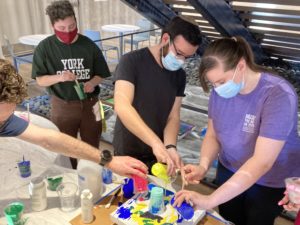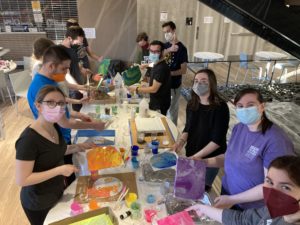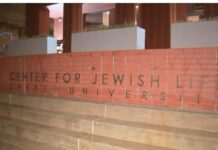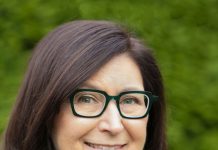
The pandemic has stolen time from everyone but particularly from college students. A typical four years of community building and connection was abbreviated for some, with Drexel University Hillel students being no exception.
Drexel Hillel Rabbi Isabel de Koninck wanted to make the most of the time students had together, finding a way to not only rebuild a young Jewish community stifled by the pandemic but to give students a way to process communal and personal loss and hardships.
The beginning of the 2021-’22 academic year was an opportunity to do that: The Hillel created an artist residency program, one of the only such Hillel programs in the country, with 2019 Tribe12 fellow and Drexel alum Danielle Abrams at the helm.
Over the course of the semester, Abrams held workshops and programming for more than 75 students, spending 300 hours on campus across the school’s fall, winter and spring terms.
The pilot program culminated in a 10-week student fellowship over the winter. The six student fellows will show their art at a gallery opening at Drexel’s Perelman Center for Jewish Life on May 12 from 6-8 p.m.
The opening will include a watercolor painting workshop and print sale, with money raised going to the Hillel International Emergency Relief Fund for Ukrainian refugees.
“It was a really creative move on our part and, really, an innovative decision by Rabbi Isabel to create a brand-new type of program that wasn’t tikkun olam; it wasn’t a text study. It was hands-on learning, using art as a tool to connect students to their Jewish identity and to their peers,” Abrams said.
Though the artists-educator residency program served all Hillel students, the fellowship was designed for students who had a deeper interest in art and community leadership.
Fellows visited local exhibits spotlighting Jewish artists, and then taught various art skills to the rest of their student community.
“Through the fellowship, they have explored Jewish art and architecture around the city and examined the ways that art has and can be used as a mode of spiritual expression, as a vehicle for wellness and a tool for social change and community-building,” de Koninck said.
Oftentimes, Abrams said, students balanced the fellowship with a full course load, internships and sometimes a part-time job. The fellowship, rather than serving as another rigorous resume-builder, was a chance for students to unwind from the business.
“This fellowship was such an incredible opportunity to connect with other Jewish artists at Drexel and bond over our shared passions,” said Drexel student artist Andrew Galitzer.

“I very much enjoyed our weekly studio sessions where we caught up and created together.”
Abrams wanted to prove that, in a time of busyness, particularly in a STEM-focused school such as Drexel, art still had a place.
“The ultimate goal of this fellowship for me wasn’t just to create an art gallery or raise awareness about Jewish artists,” Abrams said. “It was really to prove the concept that art matters. Art can be healing and deserves the time and energy that an engineering-focused university doesn’t always allot.”
The project is also dear to Abrams who, as an alum, feels as though she has the chance to coach the next generation of artists and community leaders. She graduated in 2014 with a bachelor’s in design and merchandising and was an involved Hillel member.
“It feels like I’m stepping back in time, but it also feels like coming home to a place that is so meaningful,” she said. “And it feels really rewarding to give back to Drexel Hillel in this new capacity.”
Because the residency is a pilot program, Abrams and de Koninck don’t have a road map for its future. This year, the residency used $10,000 from the Drexel Hillel budget. De Koninck is hoping to secure at least $15,000 of funding to maintain and grow the program over the next three years.
In the future, Abrams wants to take the students on trips to local exhibits and weekend retreats and hold additional workshops.
At its core, however, the art program will remain a space for students to find connection, a respite from busy schedules and what one fellow described as a “little piece of Shabbat.”
“Art is very similar to Judaism, in that it teaches us to always ask questions and dive deeper to uncover hidden emotions,” Abrams said. “And they’re both kind of vehicles for a conversation to emerge about what connects us to each other, what connects us to ourselves, what connects us to our past.”






